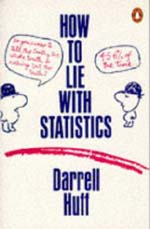'How to lie with statistics'

How to lie with statistics
By Darrell Huff
Although this book is 50 years old this year, its wisdom is needed now more than ever, as increasing computer power and our headline-obsessed media look set to drown us all in a sea of "statisticulation". This is the word coined by Darrell Huff to describe misinformation by the use of statistical material. Biased samples, dubious graphs, semi-attached figures: he describes all the usual suspects clearly and simply, rounding off with the most useful topic of all: How to Talk Back to a Statistic.
Here Huff explains "how to look a phoney statistic in the eye and face it down; and no less important, how to recognize sound and usable data in [the] wilderness of fraud". Look for bias, he advises, conscious and unconscious; find out "who-says-so" (if an "O.K. name" is cited, make sure it stands behind the information, not merely beside it); ask how the authority knows; try to find out what's missing; check whether the raw figure justifies the conclusion drawn and, most straightforwardly of all, ask yourself if the statistic makes sense.
The very final example of the book concerns trends. If you know how something is changing over some short time period, you can make the situation seem much more extreme by projecting the trend into the future and coming up with some headline-grabbing prediction. An increase of, say, a percent in the rate of some disease over the last ten years can be converted into an epidemic of biblical proportions if you just predict that the trend continues unchanged for long enough. Of course, there may be no particular reason to believe that the trend will continue, but in the meantime, you have got your headline and the media have their scare story (see Editorial trends in this issue of Plus for a current example).
"How to lie with statistics" is entertainingly illustrated with original cartoons, and written in a clear and easy style (Huff was a professional author who had done postgraduate work in statistics, rather than a professional statistician trying to preach to the non-numerate). It is short - 128 pages and that includes illustrations - so you can easily read it at a single sitting. And it could be one of the most valuable investments of £6.39 (from Amazon UK) and two hours of your time you will ever make.
- Book details:
- How to lie with statistics
- Darrell Huff
- paperback - 128 pages (1991; first printed 1954)
- Penguin Business
- ISBN: 0140136290
- Buy it from Amazon UK
About the reviewer
Helen Joyce is editor of Plus.